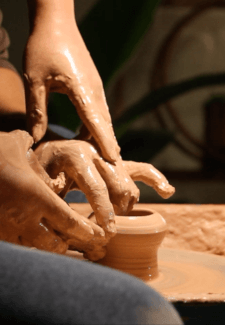Imagine the perfect morning on the bank of a tranquil river. The water is slow-moving and glassy. The only sounds are birds chirping and a gentle breeze whispering through the grass.
You are relaxed.
Now, imagine you begin to hear some distant sounds of movement coming from up river. Maybe you hear splashing, maybe faint yelling, as if a group of people is chanting. You can hear them only shortly before their figures start to become visible in the distance.
Before you can believe it, they are upon your stretch of tranquility. The first thing you notice in detail is the giant carved head of a dragon, painted in vibrant colors, its lips peeled back in an intimidating smile. Sitting directly behind the beast’s white horns, a man straddling a giant drum is facing a crew of what looks like two dozen rowers sitting side by side in the narrow hull of the boat. Each is paddling in time with the drum, each blade slicing into the water at exactly the same time. You cannot believe how quickly and technical their movements are. At the back of the boat sits a woman, shouting orders and counting along with the drum. Directly behind her, the graceful tail of the dragon sweeps up out of the water, leaving a sizable wake behind the boat.
Then, they are gone. In just a few seconds, the boat traversed a space you would previously have thought impossible. The water is still churning behind their frenzied motion.
In the sudden silence, your heart is beating. Your adrenaline is pumping. You don’t want your tranquil setting back; you want to get onboard.

The best place to start is to join a dragon boat racing introductory class. Luckily, Naga Spirit Dragon boating in Pyrmont, Sydney offers a beginner’s course that is the perfect way to ease into the complex sport. Before you begin, you may want to review the historical context of dragon boat racing, so that you can impress your new teammates and gain an appreciation for the sport.
Let’s start with the most important aspect of dragon boat racing, the boat. According to Chinese tradition (1), the ornate design of the boat is very specific: an ox-like head, deer’s antlers, a stallion’s mane, reptilian scales, and the tail of a fish. The paddles in between are reminiscent of the animal’s many claws, moving in time while the dragon flies through clouds.
The boats are thought to have ancient religious origins, with some believing their role to be appeasement of the rain god. The Dragon Boat Festival, recorded over 2,000 years ago, boasts of several origin stories, varying by region. A popular one (2) tells the story of Qu Yuan, a beloved advisor to the king turned exiled poet whose suicide by drowning in the river sparked widespread grief. In looking for the deceased hero, his followers rowed into the river and threw rice into the water to distract the fish.
Subsequently, the festival has become a large cultural tradition, and people from all over the world have adopted the invigorating sport.
In accordance with racing rules, there is always a drummer (sitting at the front) and a steer (at the rear.) Traditional festivals can boast of crews of up to 50 rowers, but standard rules allow for 18 to 20 in the large boats, and 8 to 10 in the smaller versions.
So, now that you’re equipped with a foundational knowledge of the sport’s cultural roots, what does an introductory class look like?
Well, you’ll probably spend a lot of a time on land. As a technical sport with some risks, there are a few things to learn before getting into the water, like safety procedures, basic paddle technique, and how to get in and out of the boat (it may sound silly, but that is one squirrely vessel when you’re stepping onto it from dry land.) This class is also good time to go over the rhythm and timing that are so crucial to a cohesive crew.
Speaking of the crew, the initial class, while informative, is a great opportunity for the crew to start bonding. As an inherently social sport, the integration of individual members into a team is an incredibly important element to successful dragon boat racing. In other words, don’t be shy! Get to know your team!
Each subsequent class will incorporate more water time, but be prepared to start most sessions with dry land training. After all, dragon boat racing is an athletically demanding sport, so be prepared to put in that physical training!
During your first few sessions, you will probably experience some of the obvious joys of dragon boat racing. The teamwork. The beautiful setting. The sense of accomplishment that comes from hard work.
Yet, there are a few hidden benefits to dragon boat racing that you may not even realize. For instance, did you know that dragon boat racing can positively affect your mental state and have long-term effects on your physical health?
It’s true: dragon boat racing is shown (3) to decrease stress levels, improve self-esteem and increase energy levels while creating an overall sense of accomplishment and confidence in rowers of all ages. Many agree (4) that that teamwork can have a positive effect on mental health, as well.
Without a doubt, the physical advantages of dragon boat racing are also well worth the effort. Rowing requires the toning of several muscle groups in the body: neck, shoulders, back, chest, abdominals, obliques, hips, and thighs, to name a few. Within a few weeks of intense training, you’ll start to notice the results (try not to break too many fragile objects with your new strength in the process.)
Your practices will increase your overall cardiovascular health as well as heighten your coordination as a result of working so closely with your fellow rowers. Of course, we all know the vast benefits of being physically fit, from reduced risk of heart disease to improved stamina.
So, if you’re looking for adventure, community, and fun, dragon boat racing might just be the sport for you. Look into classes in your area to get training today!
References:
1.idbf.org
2.chinahighlights.com
3.dragonboatco.com
4.journals.lww.com




















